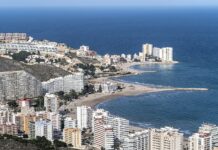1. Environment minister denies mining company appeal
One of St Barbara’s “non-core” assets is its Touquoy open pit gold mine in Moose River, Nova Scotia. Credit: Raymond Plourde / Ecology Action Centre
St. Barbara Ltd, the Australian mining company that operated the now-closed Touquoy open pit gold mine in Moose River, appealed to environment minister Tim Halman in an effort to get out of fulfilling its site reclamation obligations. But Halman was having none of it, Joan Baxter reports.
Baxter has reviewed correspondence between the parties, and contrasts Halman’s tone with that of St. Barbara CEO Andrew Strelein:
The tone of Halman’s letter to the AMNS [Atlantic Mining Nova Scotia] counsel is diplomatic, measured and professional, the antithesis of the letter he received from St Barbara on April 29, 2024, appealing the NSECC March 2024 industrial approval…
In a tone that alternates between whining, petulant and belligerent, sometimes with a hint of paranoia, Strelein accuses Halman’s department of everything from “entrapment” to rebuffing the company “with either arbitrarily imposed requirements or explanations that demonstrate no comprehension of the supporting studies prepared by third party experts,” and of setting “arbitrary and unrealistic dates for submissions of study reports.”
“Your NSECC [Nova Scotia Environment and Climate Change] have added conditions in this latest approval that cannot be met, are without scientific basis and contradictory to the best third-party independent advice on water criteria and with respect to appropriate compliance points,” Strelein asserts.
Strelein writes that:
…the exposure to prosecution on the basis of the most recent round of conditions from your NSECC are simply beyond what any director can be expected to endure – conditions that are inconsistent with what any science-based mining regulator would reasonably impose and certainly by any other province in the country.
Strelein, an Australian who runs St Barbara from its headquarters in Perth, Australia, then accuses NSECC of harming gold mining companies, apparently just by doing its job of protecting the environment.
Click or tap here to read “St Barbara’s appeal of Nova Scotia government requirements for Touquoy gold mine reclamation gets firm ‘no’ from environment minister.”
(Send this item: right click and copy this link)
2. Halifax municipal election: electors’ list

Yesterday, Halifax issued a media release encouraging residents to check the list of electors and make sure they are on it for the fall election.
The release says:
Eligible voters in the Halifax Regional Municipality are encouraged to verify if they are on the elector’s list for the 2024 Municipal Election by Aug. 30.
The elector’s list will be used to send out voter information letters in September, which will provide residents with important information about how and where to vote in the 2024 Municipal Election this fall.
I would encourage you to follow this advice.
By coincidence, I had happened to check the list myself the day before the release was issued. I had no doubt I would be on the list — I have lived at the same location for 26 years and have voted in every election. But what the the heck. No harm in checking.
Well, it turns out I was not on the list, and neither was my partner. The problem was rectified with a quick call to the number provided on the page. But clearly, it is worth taking a few moments to ensure you will be eligible to vote.
You can search the list of electors here.
(Send this item: right click and copy this link)
3. Spring Garden transit-only pilot still dead
Over at The Coast, Matt Stickland writes that “the Spring Garden Transit-only pilot is dead for at least another year.”
As you may recall, the pilot was a half-hearted attempt in July 2022 to turn Spring Garden Road into a street which would not allow private cars. Buses yes, cars no. You may also recall that the pilot lasted only a couple of days, as drivers ignored all the signs telling them they were not allowed to drive on the street and just kept doing it anyway.
(Of course the real problem with downtown traffic is cyclists who don’t always come to a full stop. But I digress.)
Stickland outlines what’s happened since then: a staff report with a suggestion that physical barriers be installed; the possibility of revisiting the pilot in 2023, then 2024. A report was said to be coming to the transportation standing committee this month but, alas, it is not on the agenda. Stickland writes:
We are now quickly approaching the four-year anniversary of council’s instructions to staff to make Spring Garden a transit-only corridor…
Based on the (lack of) progress so far, it will likely take over four years spanning two council terms for our municipal government to restrict car traffic on two city blocks. This is a relatively minor project—it’s installing some gates, not redesigning the Windsor Street Exchange—and the city has all the power it needs to enact this change. And yet, our city struggles to achieve what should be a very easy task for a “world class” city like Halifax.
Stickland’s article reminded me of my own pieces on the Spring Garden pilot, and in particular my interview with Dalhousie University health promotion professor Sara Kirk. Kirk told me there are similar projects in several places she has visited, and they have all figured out ways to prevent private cars from accessing the streets, while allowing those with a legitimate reason to be there to drive through.
She referred to Margaret Island in Budapest, where gates limit traffic, but a transponder can open them. So buses and taxis can drive through. In Bratislava, which she described as “quite like Halifax in some ways,” lots of downtown deliveries were made by cargo bike, and red lights clearly indicated to drivers where they could not pass. And in Berlin, “They have those retractable bollards to stop people from coming up the roads.”
I noticed bollards like these in Haarlem, in the Netherlands last month. I was enjoying a sandwich at a cafe, watching the sea of people going by on foot, on bikes, on scooters, using various mobility aids and so on. The street in front of us had a solid bollard that prevented cars from driving on it. But what if there are cars who need to be on the street? Well, you install a transponder. Or, as in the video above, which I shot while eating that sandwich, you give the drivers a card to tap. It lowers the bollard, they drive through, and then the bollard goes back up, clearly indicating that the street is not meant for cars.
As Kirk said in that interview, “Other places have figured this out. It’s not rocket science.”
(Send this item: right click and copy this link)
4. No Frills oops
 Credit: Farmers’ Markets of Nova Scotia.
Credit: Farmers’ Markets of Nova Scotia.
This is Farmers’ Market Week in Nova Scotia (a marketing event promoted by the organization Farmers’ Markets of Nova Scotia). It’s also the week No Frills shops (owned by Loblaw) sent out marketing texts that said, “Skip the line at the farmer’s market. We have fresh produce at low prices.” Then there was a link to a flyer.
Well, as you can imagine, this did not go over super well with the folks at FMNS. On their Instagram, they posted a critique of the ad, then shared a post saying that in response No Frills “told us that they ‘remain committed to supporting Canadian farmers and growers.’”
The post continues:
This giant corporation felt the need to punch down at small scale producers in order to promote their flyer, which they purport is built to support local farmers. But if a huge grocery chain asks you to avoid the very places where farmers are offered a fair price in the first place, then clearly they’re missing the point.
To me it seems like weird marketing. When I think lineups, I associate long lineups much more with grocery stores than with farmers’ markets.
(Send this item: right click and copy this link)
5. Blackburn, Outhit and Smith bow out
 Coun. Lindell Smith at council’s swearing-in ceremony in 2020. Credit: Zane Woodford
Coun. Lindell Smith at council’s swearing-in ceremony in 2020. Credit: Zane Woodford
Over at SaltWire, Jen Taplin interviews three Halifax councillors who are not standing for re-election: Lindell Smith, Tim Outhit, and Lisa Blackburn.
Interestingly Smith, who was 26 when he was first elected, said he originally hoped to distance himself from the role of first Black councillor in 15 years:
“Looking back, I didn’t realize until my second term what that actually meant at the time … I really focused on being young and Black just happened to be part of it,” said Smith, 33, who was 26 when he was first elected.
“I realized it actually is important for representation but also in terms of perspective and understanding city and governance. I kind of wanted to walk away from folks just seeing me as the first Black councillor in 15 years, but I understood later on this is why it is important.”
The always quotable Outhit tells Taplin, “It’s a job where you really can make a difference and that is the big thing. It can be a little thing like picking up the phone … it could be about a $50 million development and the next thing is what to do with a dead raccoon.”
(Send this item: right click and copy this link)
‘Effective cycling’ and who it leaves out
 Taking the lane. Credit: Getty/Unsplash
Taking the lane. Credit: Getty/Unsplash
The last two episodes of the War on Cars podcast have been devoted to a (perhaps overly) deep dive into John Forester’s 1976 book Effective Cycling.
Forester was an influential engineer and avid cyclist, who was best known for his promotion of “vehicular cycling” — the idea that bicycles are vehicles and belong in traffic along with cars. He was opposed to bike lanes, and feared that building bike infrastructure would lead to bikes being banned from streets, where they belonged.
The hosts of the War on Cars, Doug Gordon, Sarah Goodyear, and Aaron Naparstek, argue that this stance put the cause of widespread bike adoption back by decades. It let cities off the hook, in effect, by presenting a particular cyclist point of view that said “We don’t want bike lanes.” Great! They don’t want bike lanes, so we don’t need to build them.
Gordon remembers living in Boston, and going to meetings where the vehicular cyclists would show up:
What was striking about them, when they’d show up to meetings and advocate against bike lanes, you know, you’d have these parents getting up at the meeting and they’d be like, “You know, I’m just trying to bike my kids to school safely.” And then these guys would argue against it.
In some ways, the vehicular cycling argument is simple: bicycles and cars are both vehicles. The rules of the road are laid out clearly, make sense, and most people obey them. If you follow the rules, you’ll be fine. There is a right way to bike, and if you bike the right way, no problem.
Forester and his followers had little time for advocates like Bicycle Bob Silverman (who I wrote about for the Examiner here.) They saw them as engaging in stunts, instead of focusing on the right way to ride.
As a young (white and male) cyclist, I had never heard of Forester and his book, and I didn’t even know the term vehicular cycling until I listened to the podcast. But I was definitely drawn to the idea.
Living in a city (Montreal) which at the time had almost no bike lanes, I embraced the notion that bikes should be right out there in traffic. Fuck you, I’m on a vehicle, I can go almost as fast as you in these driving conditions (you’d see the same people at every red light), and I have every right to the road. Same as you.
For a while, I rode to my job at the National Film Board along Décarie Blvd. Montrealers will know what I’m talking about, and I’m trying to think of a Halifax equivalent. Maybe like riding along the Windsor Street Exchange approach to the new bridge.
Was it a pleasant ride? No. It was adrenaline-fuelled though, and I would arrive at work sweaty (there were showers next to my office) and on a bit of a high.
During this period, I would be irritated when I saw people dismount from their bikes to walk across the street at intersections. Are you a pedestrian or a vehicle? You’re riding a vehicle! Get back on your bike!
Of course, this kind of wrong-headed thinking completely ignores one of the strengths of bicycles: That they are versatile and allow you to quickly adapt to the circumstances in which you are riding. Why not get off and walk your bike across the street? It’s not like riding a bike is some kind of purity test.
But the thing is, this vision of cycling is like a purity test. It’s for people who are comfortable going toe-to-toe with drivers and damn the consequences. The consequences can sneak up on you though. My period of riding like this ended when a driver opened his door and hit me, sending me flying into traffic on Décarie. I ended up with a concussion (my second) and was lucky not to be killed. Forester’s attitude to this is that I should not have been driving in the door zone.
The other thing is, who does this type of cycling exclude? Several years ago, I interviewed someone (it actually might have been Sara Kirk again) and talked about how I used to have this “take the lane” attitude towards cycling. And the person I was interviewing said something along the lines of, “But who does that? Basically young men, and that’s it. Nobody else is willing to ride like that.”
Over and over again I hear from people who would like to bike more but feel they don’t have the skill to ride in traffic, which is what cycling in Halifax so often entails. Drivers don’t all follow the rules of the road. They blow through red lights, they turn in front of you, and so on. Sure, cyclists don’t all follow the rules of the road either, but the consequences are far less dire. What’s needed is better infrastructure, not teaching people to have the confidence to ride out in traffic.
On the podcast, you can hear Goodyear trying not to lose it at some of the advice Forester offers in the book on everything from how to carry your bike properly to what to do in traffic if a driver cuts you off.
In one striking section, Goodyear reads from the book, and then offers her commentary. The part in quotes is from the book:
Sarah Goodyear: “If you meet someone who insists on running you off the road, don’t let it happen. The driver won’t succeed, of course, because you know how to handle that by now. But don’t let the driver get away with the attempt. First time, let it go. But note the car type, colour, and even license number if you can. Second time, so long as the driver is disobeying the law and you are obeying it, stick up for your rights… Wait till traffic stops. Dismount. Place your bike crosswise in front of the car and ask if you can help. If your annoyer tries to scrape you or shouts at you as he or she goes by, give chase to the next traffic stop. Ride up beside the driver’s window and say you have exactly as much right to use the road as he or she has. No more, but certainly no less. Two or three of these in two months, and you will probably never be mistreated again on your commute route,” because you will be dead..
Aaron Naparstek: …Who’s going to feel comfortable doing this? Gumming up the works, like stopping the whole thing and telling a driver, “Debate me, bro.” Who is this for?
SG: I’ll tell you one person it’s not for. It’s not for women at all, period. And I haven’t really said much about that up to this point, because I do know there are women who subscribe to this philosophy, but everything about this is just something that women would never, ever do unless they were, you know, a real outlier. This is not how women move through the world. This is not how women see the world. Women know that angry men are dangerous and that they will kill you, and they won’t care about going to trial later. Not to mention that this is also a very white perspective.
I think the attitude of people like Forester and, to a lesser extent, my younger self is notable in that it serves as a fine example of how we can universalize our own experience and ignore the needs of others. (And let’s face it, those of us in my demographic are particularly prone to this.)
I first heard of these two episodes of the War on Cars in a thread on Bluesky. It involved several local women saying that listening to the discussion made them think about guys they had seen at meetings arguing against bike lanes, and various mansplainers on local Facebook groups.
(Send or post this item as a separate article: right click and copy this link)
NOTICED
On the radio
![]()
Yvette d’Entremont and I were both guests on the local Radio-Canada French-language morning show Le Réveil this morning. We were invited onto the show to talk about the Halifax Examiner’s milestone tenth anniversary. (Tim Bousquet does not speak French, Yvette is a Francophone, and I’m pretty fluent, so we got the invite.)
The segment runs about 10 minutes, and you can listen to it here.
(Send this item: right click and copy this link)
Government
City
Transportation Standing Committee (Thursday, 1pm, City Hall and online) — agenda
Province
No meetings
On campus
Dalhousie
PhD Thesis Defence: Biology (Thursday, 2pm, Room 3107, Mona Campbell Building and online) — Catherine Bannon will defend “Cobalamin and other b-vitamins in the Northwest Atlantic Ocean”
Mount Saint Vincent
Inclusive Insights: Research Findings & Solutions for Food Insecurity Among LGBTQ+ Nova Scotians (Thursday, 6pm, Nova Scotia Health Innovation Hub, 12th floor, Nova Centre) — Mount Saint Vincent University researcher Dr. Phillip Joy, together with colleagues from Feed Nova Scotia, will present the results of their recent research; for more info, contact this person
In the harbour
Halifax
07:00: Liberty of the Seas, cruise ship with up to 4,414 passengers, arrives at Pier 22 from New York, on a four-day roundtrip cruise out of New York
07:00: Oceanex Sanderling, ro-ro container, moves from anchorage to Fairview Cove
10:00: Melvin Bell, US coast guard cutter, sails from Dockyard for sea
11:00: MSC Annick, container ship, arrives at Pier 42 from Sines, Portugal
12:00: Algoma Verity, bulker, sails from Gold Bond for sea
16:00: Grande Sierra Leone, ro-ro container, sails from Autoport for sea
16:00: Augusta Luna, cargo ship, arrives at Pier 27 from Moa, Cuba
17:00: Ef Ava, container ship, arrives at Pier 42 from Portland
18:00: CB Pacific, oil tanker, arrives at Irving Oil from New York
18:00: Liberty of the Seas sails for New York
21:30: MSC Annick sails for sea
22:00: Ef Ava sails for Reykjavik
Cape Breton
06:00: John P Oxley, tank barge, moves from Mulgrave to EverWind
15:00: John P Oxley moves back to Mulgrave
Footnotes
I had hankering for bacon and eggs for breakfast today, but instead I made a smoothie with raspberries from the patch in our front yard. Good choice.
Related articles
Source link : https://www.halifaxexaminer.ca/morning-file/effective-cycling-and-who-it-leaves-out/
Author :
Publish date : 2024-07-25 14:04:25
Copyright for syndicated content belongs to the linked Source.





















































